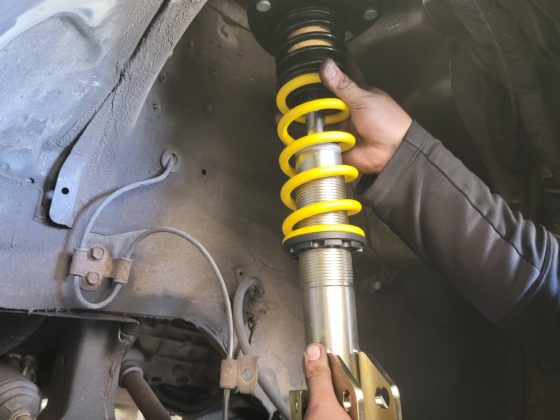
Shims can be inserted at this joint in the lower control arm like all late model GT and cup cars for rough camber adjustment.

This eccentric at the top outer pivot of the upper control arms allow for fine-tuning of the camber. You can see the double shear mounting of the upper ball joint. You can also adjust the steering axis inclination angle here as well. The GT3 has race car levels of adjustment in the front suspension.

The 992 GT3 also has a lot of innovative under-car aero going on. The GT3 has up to 150 percent more downforce than its predecessor depending on how it is adjusted. When in full downforce condition, it even has more downforce than the 991 GT3RS. These air guide vanes are very close to the ones done on the Hoonipigasarus. The new GT3 like the 991 GT3 has a flat bottom but the 992 is even flatter, with the entire bottom of the car covered with flat panels. The 911 had panels that covered the parts of the bottom that were not flat but some of the original floor was still visible even though it was nearly perfectly flat.

These vanes and wheel well shelves help strip air off the rotating tire as well as divert air from the wheel well area to the outside of the car. This helps improve the effectiveness of the front diffuser and reduces the pressure in the wheel well. The vanes prevent airflow falling from the sides of the car from curling under it and energizes the airflow in the center of the floor to improve the effectiveness of the rear diffuser.




3 comments
“Apparently, Porsche found that direct-injected engines make particulates like a diesel. We assume that the car probably has some sort of regeneration cycle to clean the traps that makes a lot of heat, hence this metal-lined scoop.”
Dfi engines do create fine particules. It’s mendatory in Europe now to have a GPF on all engines. The only difference is EU spec cars (for PORSCHE) have a differential pressure sensor, US cars do not.
The normal regen cycle on gasoline engines takes place when you’re coasting, it’s the only time where a gasoline engine has enough oxygen in the exhaust to burn the particules.
There is also a forced regen mode. I’m not sure but I think it uses secondary air injection to get oxygen in the exhaust. Porsche informs that it must be performed with a lot or airflow passing under the car because with the car stationnary, the red hot GPF could potentially damage the road it’s on (and everything around it).
I really like the diffuser to brake scoop design.
My theory on the move to SLA double wishbone front is that the Cayman was posing a serious track threat and they needed to further differentiate the cars with a significant suspension upgrade on the 911.
Also, they could finally put the real GT3 engine in the Cayman GT4 RS without actually eclipsing the 992 911 GT3.
Great article. Would have been great to get some more zoomed out overall photos of the underside to understand how much of the floor is flat bottomed. The number of aero details is staggering